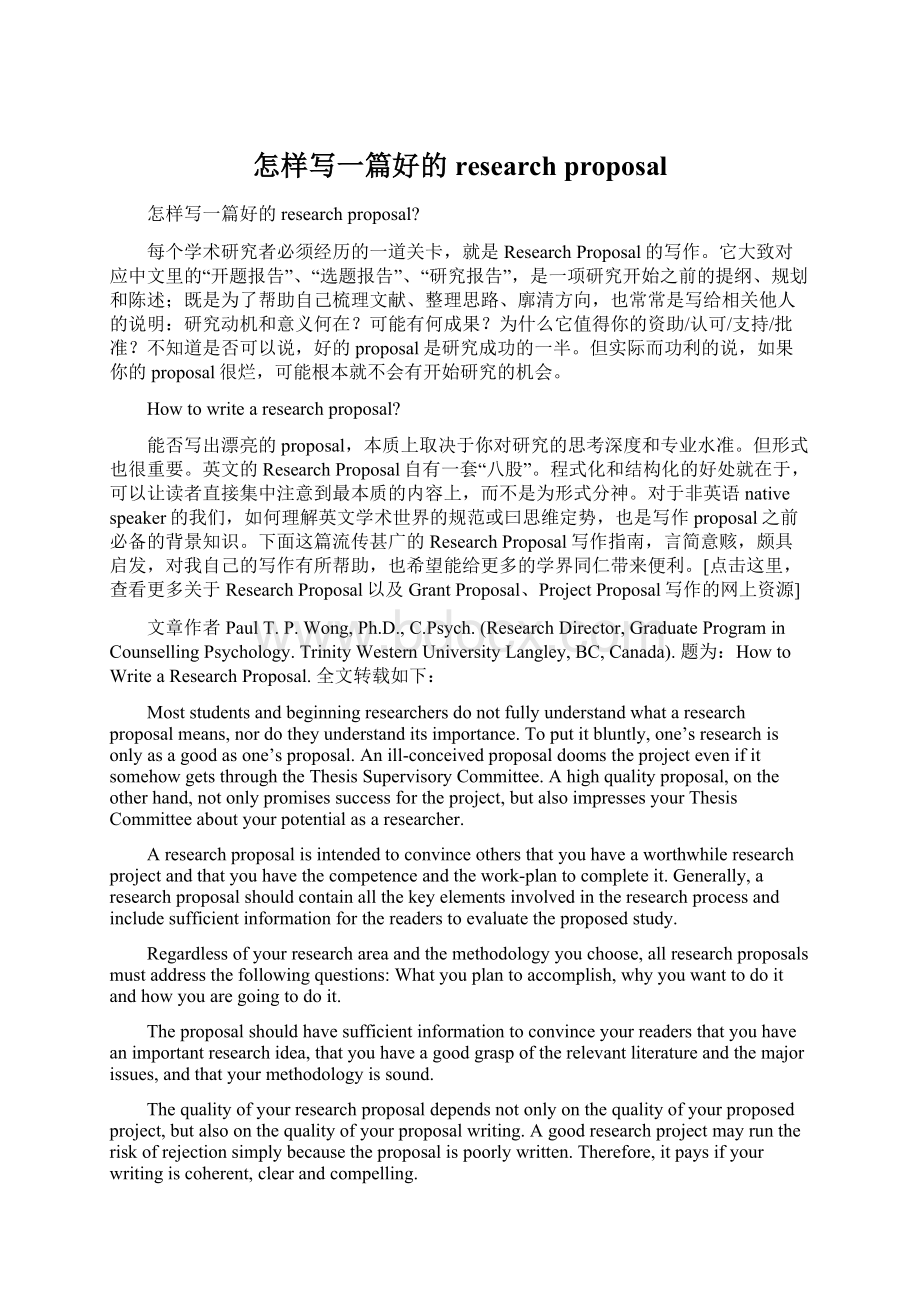怎样写一篇好的research proposal.docx
《怎样写一篇好的research proposal.docx》由会员分享,可在线阅读,更多相关《怎样写一篇好的research proposal.docx(9页珍藏版)》请在冰豆网上搜索。

怎样写一篇好的researchproposal
怎样写一篇好的researchproposal?
每个学术研究者必须经历的一道关卡,就是ResearchProposal的写作。
它大致对应中文里的“开题报告”、“选题报告”、“研究报告”,是一项研究开始之前的提纲、规划和陈述;既是为了帮助自己梳理文献、整理思路、廓清方向,也常常是写给相关他人的说明:
研究动机和意义何在?
可能有何成果?
为什么它值得你的资助/认可/支持/批准?
不知道是否可以说,好的proposal是研究成功的一半。
但实际而功利的说,如果你的proposal很烂,可能根本就不会有开始研究的机会。
Howtowritearesearchproposal?
能否写出漂亮的proposal,本质上取决于你对研究的思考深度和专业水准。
但形式也很重要。
英文的ResearchProposal自有一套“八股”。
程式化和结构化的好处就在于,可以让读者直接集中注意到最本质的内容上,而不是为形式分神。
对于非英语nativespeaker的我们,如何理解英文学术世界的规范或曰思维定势,也是写作proposal之前必备的背景知识。
下面这篇流传甚广的ResearchProposal写作指南,言简意赅,颇具启发,对我自己的写作有所帮助,也希望能给更多的学界同仁带来便利。
[点击这里,查看更多关于ResearchProposal以及GrantProposal、ProjectProposal写作的网上资源]
文章作者PaulT.P.Wong,Ph.D.,C.Psych.(ResearchDirector,GraduatePrograminCounsellingPsychology.TrinityWesternUniversityLangley,BC,Canada).题为:
HowtoWriteaResearchProposal.全文转载如下:
Moststudentsandbeginningresearchersdonotfullyunderstandwhataresearchproposalmeans,nordotheyunderstanditsimportance.Toputitbluntly,one’sresearchisonlyasagoodasone’sproposal.Anill-conceivedproposaldoomstheprojectevenifitsomehowgetsthroughtheThesisSupervisoryCommittee.Ahighqualityproposal,ontheotherhand,notonlypromisessuccessfortheproject,butalsoimpressesyourThesisCommitteeaboutyourpotentialasaresearcher.
Aresearchproposalisintendedtoconvinceothersthatyouhaveaworthwhileresearchprojectandthatyouhavethecompetenceandthework-plantocompleteit.Generally,aresearchproposalshouldcontainallthekeyelementsinvolvedintheresearchprocessandincludesufficientinformationforthereaderstoevaluatetheproposedstudy.
Regardlessofyourresearchareaandthemethodologyyouchoose,allresearchproposalsmustaddressthefollowingquestions:
Whatyouplantoaccomplish,whyyouwanttodoitandhowyouaregoingtodoit.
Theproposalshouldhavesufficientinformationtoconvinceyourreadersthatyouhaveanimportantresearchidea,thatyouhaveagoodgraspoftherelevantliteratureandthemajorissues,andthatyourmethodologyissound.
Thequalityofyourresearchproposaldependsnotonlyonthequalityofyourproposedproject,butalsoonthequalityofyourproposalwriting.Agoodresearchprojectmayruntheriskofrejectionsimplybecausetheproposalispoorlywritten.Therefore,itpaysifyourwritingiscoherent,clearandcompelling.
Thispaperfocusesonproposalwritingratherthanonthedevelopmentofresearchideas.
Title:
Itshouldbeconciseanddescriptive.Forexample,thephrase,“Aninvestigationof...”couldbeomitted.Oftentitlesarestatedintermsofafunctionalrelationship,becausesuchtitlesclearlyindicatetheindependentanddependentvariables.However,ifpossible,thinkofaninformativebutcatchytitle.Aneffectivetitlenotonlypricksthereader’sinterest,butalsopredisposeshim/herfavourablytowardstheproposal.
Abstract:
Itisabriefsummaryofapproximately300words.Itshouldincludetheresearchquestion,therationaleforthestudy,thehypothesis(ifany),themethodandthemainfindings.Descriptionsofthemethodmayincludethedesign,procedures,thesampleandanyinstrumentsthatwillbeused.
Introduction:
Themainpurposeoftheintroductionistoprovidethenecessarybackgroundorcontextforyourresearchproblem.Howtoframetheresearchproblemisperhapsthebiggestprobleminproposalwriting.
Iftheresearchproblemisframedinthecontextofageneral,ramblingliteraturereview,thentheresearchquestionmayappeartrivialanduninteresting.However,ifthesamequestionisplacedinthecontextofaveryfocusedandcurrentresearcharea,itssignificancewillbecomeevident.
Unfortunately,therearenohardandfastrulesonhowtoframeyourresearchquestionjustasthereisnoprescriptiononhowtowriteaninterestingandinformativeopeningparagraph.Alotdependsonyourcreativity,yourabilitytothinkclearlyandthedepthofyourunderstandingofproblemareas.
However,trytoplaceyourresearchquestioninthecontextofeitheracurrent“hot”area,oranolderareathatremainsviable.Secondly,youneedtoprovideabriefbutappropriatehistoricalbackdrop.Thirdly,providethecontemporarycontextinwhichyourproposedresearchquestionoccupiesthecentralstage.Finally,identify“keyplayers”andrefertothemostrelevantandrepresentativepublications.Inshort,trytopaintyourresearchquestioninbroadbrushesandatthesametimebringoutitssignificance.
Theintroductiontypicallybeginswithageneralstatementoftheproblemarea,withafocusonaspecificresearchproblem,tobefollowedbytherationalorjustificationfortheproposedstudy.Theintroductiongenerallycoversthefollowingelements:
1.Statetheresearchproblem,whichisoftenreferredtoasthepurposeofthestudy.
2.Providethecontextandsetthestageforyourresearchquestioninsuchawayastoshowitsnecessityandimportance.
3.Presenttherationaleofyourproposedstudyandclearlyindicatewhyitisworthdoing.
4.Brieflydescribethemajorissuesandsub-problemstobeaddressedbyyourresearch.
5.Identifythekeyindependentanddependentvariablesofyourexperiment.Alternatively,specifythephenomenonyouwanttostudy.
6.Stateyourhypothesisortheory,ifany.Forexploratoryorphenomenologicalresearch,youmaynothaveanyhypotheses.(Pleasedonotconfusethehypothesiswiththestatisticalnullhypothesis.)
7.Setthedelimitationorboundariesofyourproposedresearchinordertoprovideaclearfocus.
8.Providedefinitionsofkeyconcepts.(Thisisoptional.)
LiteratureReview:
Sometimestheliteraturereviewisincorporatedintotheintroductionsection.However,mostprofessorspreferaseparatesection,whichallowsamorethoroughreviewoftheliterature.
Theliteraturereviewservesseveralimportantfunctions:
1.Ensuresthatyouarenot“reinventingthewheel”.
2.Givescreditstothosewhohavelaidthegroundworkforyourresearch.
3.Demonstratesyourknowledgeoftheresearchproblem.
4.Demonstratesyourunderstandingofthetheoreticalandresearchissuesrelatedtoyourresearchquestion.
5.Showsyourabilitytocriticallyevaluaterelevantliteratureinformation.
6.Indicatesyourabilitytointegrateandsynthesizetheexistingliterature.
7.Providesnewtheoreticalinsightsordevelopsanewmodelastheconceptualframeworkforyourresearch.
8.Convincesyourreaderthatyourproposedresearchwillmakeasignificantandsubstantialcontributiontotheliterature(i.e.,resolvinganimportanttheoreticalissueorfillingamajorgapintheliterature).
Moststudents’literaturereviewssufferfromthefollowingproblems:
*Lackingorganizationandstructure
*Lackingfocus,unityandcoherence
*Beingrepetitiveandverbose
*Failingtociteinfluentialpapers
*Failingtokeepupwithrecentdevelopments
*Failingtocriticallyevaluatecitedpapers
*Citingirrelevantortrivialreferences
*Dependingtoomuchonsecondarysources
Yourscholarshipandresearchcompetencewillbequestionedifanyoftheaboveappliestoyourproposal.
Therearedifferentwaystoorganizeyourliteraturereview.Makeuseofsubheadingstobringorderandcoherencetoyourreview.Forexample,havingestablishedtheimportanceofyourresearchareaanditscurrentstateofdevelopment,youmaydevoteseveralsubsectionsonrelatedissuesas:
theoreticalmodels,measuringinstruments,cross-culturalandgenderdifferences,etc.
Itisalsohelpfultokeepinmindthatyouaretellingastorytoanaudience.Trytotellitinastimulatingandengagingmanner.Donotborethem,becauseitmayleadtorejectionofyourworthyproposal.(Remember:
Professorsandscientistsarehumanbeingstoo.)
Methods:
TheMethodsectionisveryimportantbecauseittellsyourResearchCommitteehowyouplantotackleyourresearchproblem.Itwillprovideyourworkplananddescribetheactivitiesnecessaryforthecompletionofyourproject.
TheguidingprincipleforwritingtheMethodsectionisthatitshouldcontainsufficientinformationforthereadertodeterminewhethermethodologyissound.Someevenarguethatagoodproposalshouldcontainsufficientdetailsforanotherqualifiedresearchertoimplementthestudy.
Youneedtodemonstrateyourknowledgeofalternativemethodsandmakethecasethatyourapproachisthemostappropriateandmostvalidwaytoaddressyourresearchquestion.
Pleasenotethatyourresearchquestionmaybebestansweredbyqualitativeresearch.However,sincemostmainstreampsychologistsarestillbiasedagainstqualitativeresearch,especiallythephenomenologicalvariety,youmayneedtojustifyyourqualitativemethod.
Furthermore,sincetherearenowell-establishedandwidelyacceptedcanonsinqualitativeanalysis,yourmethodsectionneedstobemoreelaboratethanwhatisrequiredfortraditionalquantitativeresearch.Moreimportantly,thedatacollectionprocessinqualitativeresearchhasafargreaterimpactontheresultsascomparedtoquantitativeresearch.Thatisanotherreasonforgreatercareindescribinghowyouwillcollectandanalyzeyourdata.(HowtowritetheMethodsectionforqualitativeresearchisatopicforanotherpaper.)
Forquantitativestudies,themethodsectiontypicallyconsistsofthefollowingsections:
1.Design-Isitaquestionnairestudyoralaboratoryexperiment?
Whatkindofdesigndoyouchoose?
2.Subjectsorparticipants-Whowilltakepartinyourstudy?
Whatkindofsamplingproceduredoyouuse?
3.Instruments-Whatkindofmeasuringinstrumentsorquestionnairesdoyouuse?
Whydoyouchoosethem?
Aretheyvalidandreliable?
4.Procedure-Howdoyouplantocarryoutyourstudy?
Whatactivitiesareinvolved?